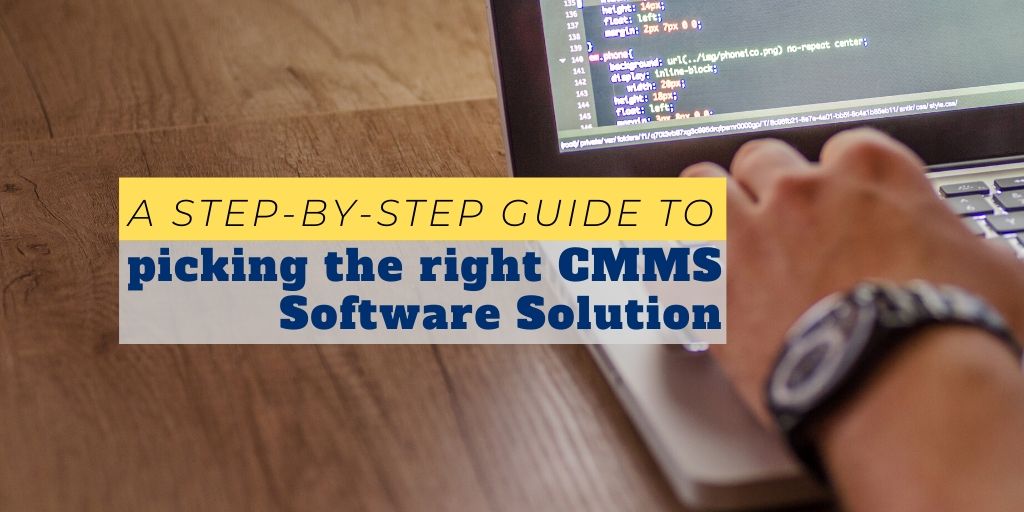
Follow these steps to select a CMMS software solution as a low-touch, low-contact workflow that allows you to automate and eliminate business redundancies
CMMS – Computerized Maintenance Management System – is an essential part of a modern property management company. If you manage a property, you know that you can no longer rely on simplistic excel documents or an archaic paper-based system to efficiently and effectively manage your organization’s workflow.
This is where a software solution like CMMS will be an essential tool you can use. Whether you are considering a new provider or are selecting your first software solution, there are some key steps and processes you should follow to land a CMMS solution that is just right for you and your business.
There are a lot of CMMS software solutions on the market. Going through them all can be quite challenging if you don’t know exactly what is a good fit for you.
In this article, we will go through a step-by-step guide on picking the right CMMS software solution for you and your business. We will also cover what to look for in an ideal CMMS software.
Step 1: Create a stakeholder team (Who will use it?)
Before you start the process of selecting a CMMS software, you need to assemble the team of individuals who will be directly affected by the software and will be interacting with the software directly. You will not have a successful software in your organization if people are not going to use it, so it is important to get the stakeholders to ‘buy-in’ to the idea.
Consider including at least one individual from the following teams to create a cross-functional team to consult when you pick the best software:
- System Admins & Process Managers
These are the individuals who will be managing the software themselves as it is a critical part of their job function to manage the overall system and workflow within the organization.
- Technical team
The end-users who will be interacting with software to conduct maintenance and report any issues.
- Preventive & Predictive Maintenance Engineers
They are responsible for proactive preventive programs that include guidelines, tools, and an action plan to prevent breakdowns. They plan the scheduled maintenance.
- Operations & Inventory
They will be the ones who interact with orders and tickets in the system. They will also be responsible for inventory management.
- IT Team
They will be supporting the technology infrastructure that will adopt the software into its ecosystem.
- Health & Safety Team
A critical team in industries where inspections and audits are common – and in a post-COVID world, they will have an even integral role to play.
- Executives
they are the decision-makers who will need insights and reporting from the system in order to strategically plan for the business.
Step 2: Figure out the pain points (Why will we use it?)
Once you have assembled a cross-functional team with representation from each area previously mentioned, it is time to ask questions to figure out the struggles within the organization that the CMMS software will seek to resolve.
This process will help uncover the question “Why will we use it?” Here is a list of questions to ask:
- What are the current maintenance strategies the organization currently uses?
- What are the biggest problems users/managers/executives face with the current system?
- How would you like the maintenance strategy to evolve? How should it change?
- What KPI and benchmarks are we looking to improve? What will define success in a CMMS software?
- Does the organization have multiple assets and areas that the CMMS will help manage?
- What is the size of order volume or workload are we looking to manage with the software?
- What health and safety measures are we looking to achieve with the help of CMMS?
These questions will crystalize the problem you are looking to solve with the CMMS software. Document the responses, and collectively work towards crystalizing the pain points, strategy direction, workflow, and expected solution.
After these questions are thoroughly discussed, you should be able to crystalize the goals you will look to accomplish by investing in the new CMMS software.
Step 3: Define the goals and budget (What is in it for us?)
Once you have brainstormed the pain points and strategy questions, it is time to define the goals and budgets for the CMMS.
This step will answer questions about the objectives you are looking to achieve with this software. As you set the goals and objectives, it will also be beneficial to figure out a budget for what you are looking to spend to achieve these objectives.
If you currently already have CMMS software, the pricing structure of that solution will help you assess your budget. If you are new to procuring a CMMS software, it will help to research prices in the industry.
In terms of the goals, here are some areas to consider:
- What percentage of workload are we expecting to be affected?
- What quantifies success (turnaround time, downtime, just-in-time repairs, preventative maintenance?)
- What are the long-term and short-term goals?
In terms of developing a budget for the procurement, look at the following areas:
- What prices does the market charge?
- What are other organizations paying for this software?
- How can we quantify the efficiency gain from using the software? (e.g. will it reduce technician time spent per job, or will it reduce delays and downtimes)?
- Do I have buy-in from stakeholders who will be approving the budget for this software procurement?
It is very important to establish a budget and a list of your top needs/goals. One of the first questions you will face when engaging a CMMS service provider is the budget.
Step 4: Finalize Requirements
After crystallizing the goals and budget items, it is time to finalize your list of requirements that you will be including in a Request For Proposal (RFP) to engage vendors.
Here is a check-list of information you will need to finalize the requirements:
- What is the annual budget that you have been approved to spend?
- What is your timeline for implementing the software?
- Do you have your wish list of requirements from the functional teams who will be using the software?
- What are your 30, 60, and 90-day objectives you wish to achieve by using the software?
- What are your IT requirements to introduce this software in your organization’s IT ecosystem?
- How many users will be using the software?
- What is your plan for adopting and training for the software? (You will work closely with the vendor on this)
- What is the start date you need to go live with the software?
Once you have finalized your requirements, it is time to engage CMMS providers.
Step 5: Engage the CMMS providers
Now that you have finalized your requirements and have received the buy-in from stakeholders for a budget and timeline to implement the system, it is time to engage the CMMS providers.
You can start the process with an RFP (request for proposal) if you are doing this for a larger enterprise. You can also individually contact vendors.
One of the best practices is to engage at least three vendors before procuring a software solution.
In the process, ask for an initial discovery meeting where they will explore your needs and conduct their own needs analysis. They will then put together a custom demonstration presentation.
Here is a short-list of steps in engaging vendors:
- Prepare and distribute RFP
- Invite vendors for a meeting
- Request a demo presentation
- Ask for trials for users to interact with the software live
- Accept proposals with pricing and software details to assess IT requirements
- Ask for current clients and reviews/testimonials
Once you have gone through the engagement process with vendors, you will move into the phase of evaluating their proposals
Step 5: Evaluation of Proposals
Once you receive proposals from the vendors, it is time for you to evaluate the proposals to achieve an apple-to-apple comparison.
Here are some steps you can take to evaluate proposals in order to narrow down the list:
- First, evaluate if the features included in the software meet your specific needs. This is something you should have been able to flush out through the demo process and through Q&A with the company.
- Second, divide the features between nice-to-have and need-to-have. This is quite critical, as exploring features that are not essential can lead to spending valuable time and resources for very little ROI.
- Evaluate customization options and which ones offer a tailor-made solution. One size does not fit all, and software vendors know this and will work with you to customize to the best of their abilities.
- Evaluate the pricing plan based on the features they provide.
- If a vendor does not offer a feature that you think is critical, eliminate them even if they are a cheaper option.
- Evaluate the cost of implementation, training, and on-going support.
- Review client testimonials and user reviews.
- Review user experience from the users who have been able to utilize the trial period.
Once you go through these steps, narrow down the list to the top contenders.
Step 6: Negotiation & Selection
Now that you have selected the top contenders, it is time to select the best vendor. If there is a vendor who you prefer (for price or feature) but falls slightly short on one area (like the number of training sessions included in the price), this is the time to negotiate these terms.
On the other hand, if there are some objections or concerns your IT and user team has, this is the time to overcome those objections with the vendor’s sales rep.
Once you have picked the winner, or the best software for you, it is also the time when you can ask for their terms and conditions to have your legal team review them.
This is also the time to ask for an action plan from the vendor for the implementation phase. Schedule the implementation phase along with the start date.
Once you have passed these few hurdles, it is time to sign and move on to the implementation phase.
Step 7: Implementation
This is the final and most critical phase of the process. This is the time when you implement the newly procured software throughout the organization.
In this phase, you should be focusing on:
- Engaging the customer success and training vendor teams into scheduling the phases of implementation.
- Coordinating the resources required from the technology standpoint
- Organizing the human resources required to assist in the implementation
- Selecting your power users and system admins to start implementing and training with the software.
This is an essential phase as this is where users buy-in to the software and adapt it into their workflow.
Be sure to include 30, 60, and 90-day action plans and work with your vendor to accomplish the deliverables in the crucial first quarter of the contract.
Now that we have gone through the seven steps involved in selecting the right CMMS software, let’s look at some features to look for in a software solution for your organization.
Top 5 features to look for in a CMMS software solution
In this section, we will cover some criteria that you should look for in a good CMMS software. These are the markers of a good software solution that maximizes the chances of CMMS success in your organization.
1. User-friendliness
This is an absolutely essential characteristic of a successful software. The user experience is key in the adoption and utilization of a key resource throughout your organization.
While most software solutions are doing a good job of ensuring optimal user experience, some do it better than others. This is where demonstration sessions will be helpful in assessing user-friendliness.
2. Training & support
It doesn’t matter how easy a software is to use; without training and support, new users will simply not adopt the software. Even if they did, they would not be utilizing all of the features and benefits that can truly improve the efficiency of the workflow.
Be sure to look for training and support features through in-person training, customer success teams, and web and telephone support infrastructure that the vendor is offering.
3. Software updates
In this world of rapidly changing technology and innovation, a sign of a good software solution is how often they update their CMMS applications. The more a software company invests in developing new generations (or iterations) of the software, the more agile and nimble they will be in customizing their offering to your needs, so look for this feature in your upcoming CMMS software.
4. Customization Options
Another great feature of a good software with a high risk of success for your organization is the customization options they offer. Every organization has a distinct work culture and workflow that can be quite different than their competitors in the same space.
Look for a software solution where they have invested resources in being able to customize the software to meet your organizational structure and goals. The more customization they can offer, the higher the chance of success they will have with your users.
5. Client Testimonial
A great software company, such as Axxerion Computerized Maintenance Management System, will have an impressive roster of clients and brands who rely on their software daily to complete their work. This is generally a sign that the vendor is a low-to-no-risk proposition.
If your peers regularly rely on a software vendor, it is a sign they have been able to customize solutions for their clients, offer value, and have the experience to handle your requirements.
On the flip side, there are always disruptors. They may not have as many clients, but they could provide an innovative approach in a space that is relevant to you. However, of course, a new approach comes with its own risks.
Whether a vendor is established in their space or is a start-up success story, they will have to demonstrate success stories for you to trust them with your resources and workflow management.
Final Thoughts
If the recent pandemic-related economic disruption had a lesson for us, it is that an automated centralized workflow system that requires fewer in-person interaction and contact will be a big part of the ‘new normal.’
If you haven’t already ditched your old, paper-heavy, high-contact maintenance system, the time to do so is now. The more automation and tech-heavy you become the more prepared for the future you will be.
A Computerized Maintenance Management System offers just that – an automated workflow system that can connect many different functional teams to get your organization’s work done.
The other thing this pandemic economic shock will teach us is that competition for efficient property management companies will be intense, and a fast action on health and regulation measures will be key.
A CMMS software solution can help you move towards a preventative maintenance system as a low-touch, low-contact workflow and allows you to automate and eliminate some of the redundancies in your organization.
So follow the steps above, and start your CMMS selection process today.



